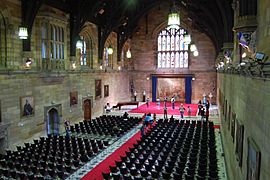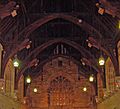Great Hall of the University of Sydney facts for kids
Quick facts for kids The Great Hallof the University of Sydney |
|
|---|---|

The interior of the Great Hall
|
|
| General information | |
| Status | Complete |
| Architectural style | Victorian Academic Gothic revival |
| Location | Main Quadrangle, The University of Sydney, Camperdown Campus, Sydney, New South Wales |
| Country | Australia |
| Coordinates | 33°53′07″S 151°11′20″E / 33.8854°S 151.1890°E |
| Construction started | 1855 |
| Completed | July 1859 |
| Owner | The University of Sydney |
| Technical details | |
| Material |
|
| Design and construction | |
| Architect |
|
| Other designers |
|
| Known for | Stained-glass windows, gables and gargoyles |
|
Invalid designation
|
|
| Official name: Main Quad / East Range and Great Hall | |
| Type | Local government (built) |
| Designated | 1999 |
| Reference no. | 4726003 |
| Group | Education |
| Category | University |
| Builders |
|
The Great Hall of the University of Sydney is a very important building at The University of Sydney in New South Wales, Australia. It is used for big events like graduation ceremonies, special meetings, concerts, and dinners. You can find the Hall in the Main Quadrangle on the Camperdown campus.
This building shows off the university's long history. It is a great example of Victorian Academic Gothic revival architecture. The Great Hall was finished in July 1859. It quickly became a popular place for visitors. In 1874, a writer named Anthony Trollope said it was "the finest chamber in the colonies." He even thought it was better than halls at Oxford or Cambridge universities.
The Great Hall, along with the Main Quadrangle and East Range, was added to a special heritage list in 1999. These buildings are called "probably the most significant group of Gothic Revival Buildings in Australia."
Contents
History of the Great Hall
Sir Edmund Thomas Blacket designed the Great Hall. He was a famous architect from 1817 to 1883. The Hall is at the very northeast part of the university Quadrangle. It stands out over the wide lawns and University Avenue.
Blacket was the Colonial Architect of New South Wales from 1849 to 1854. He left this job in 1855 to focus on designing new university buildings. He oversaw their creation and building until they were finished in 1862. Blacket also designed St. Paul's College. He also changed the design of St. Andrew's Cathedral in Sydney.
The Great Hall was completed in July 1859. It is one of Blacket's best works. On July 18, 1859, the university held its first graduation ceremony there. This was a very special day for the new graduates.
The Great Hall Organ
From 1881 to 1882, a pipe organ was put into the Hall. This organ was later replaced in 1972. The current organ was made by Rudolf von Beckerath in Germany. Ronald Sharp helped with its installation.
This organ is very complex. It has three keyboards and foot pedals. It has 54 stops and 4005 pipes. The wooden case for the organ was built at the university. It matches the Hall's architecture perfectly.
When you look at the organ, you can see the keyboards on the left. Above them are large pipes from the Great division. The Swell division is above the Great. This part of the organ is inside a wooden box with shutters. These shutters can be opened or closed with a pedal. In the middle, sticking out into the hall, is the Ruckpositiv division. The Pedal division is on the right side.
Architecture and Design
The Great Hall is known as one of the best examples of Victorian Gothic revival architecture in Australia. Its design fits perfectly with the university's Quadrangle. A special part of the Great Hall is its sloped roof. It is built in a hammerbeam style. This style looks like the roof of Westminster Hall in London.
The roof's arched shape is held up by six strong cedar beams. This design reminds people of old British buildings. Examples include Stirling Castle, Hampton Court, and Etham Castle. These are all typical Gothic buildings.
Angel Carvings and Floor
You can see twelve carved wooden angels among the roof beams. Each angel holds something that represents arts and sciences. For example, Grammar holds a papyrus scroll. Poetry has a harp. Arithmetic holds an abacus. Geometry has a famous diagram from Euclid. Astronomy has a star. Music holds a lyre. Physics has an old air pump. An angel of knowledge used to be on the eastern gable. But it was removed in 1874.
The marble floor on the western side of the hall is raised. This is like the dais in Westminster Hall. That's where King Richard II's throne once stood. The coat of arms on the southern side of the Hall is carved from Caen stone. The frame of the Oriel window is also made of this stone. The walls are built from Sydney sandstone. The floor is made of beautiful marble.
Images for kids
-
The Main Quadrangle, the University of Sydney, viewed from Great Hall


